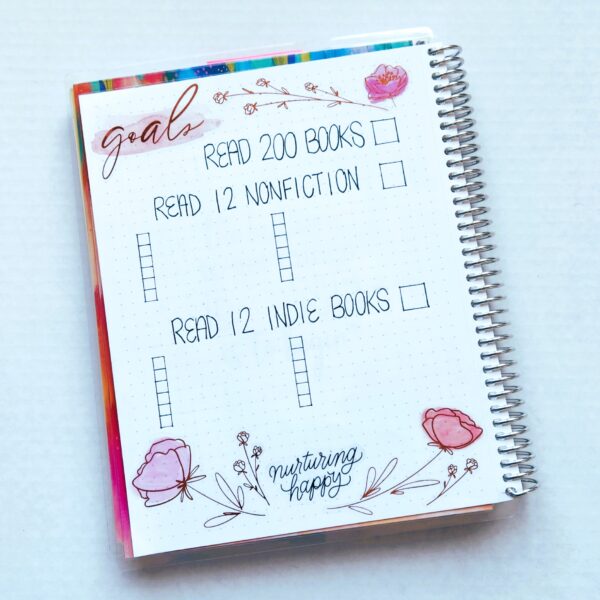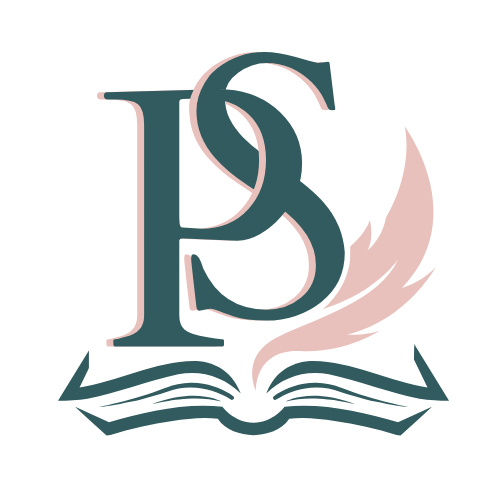Planners can be a great alternative tool for your reading journal, instead of the typical bullet journal or notebook. They can offer you more structure to your spreads without you having to take the time to create them from scratch.
In 2022, I used a planner as a reading journal and I want to share with you the ways that you can do it too.
For me, the idea of starting with a blank canvas felt too overwhelming. So a planner was the perfect solution as a way to get started without worrying about creating spreads.
You can use a 2023 planner, an undated planner, or even if you have an old planner that you never used, turning it into a reading journal is the perfect way to make sure it doesn’t go to waste because you can re-date it, or ignore the dates altogether.
I recommend, especially if this is your first time using a reading journal, to just use what you already have or find something inexpensive to try it out with first.
But if you are really wanting to treat yourself to something nice, here’s what I use.
In 2022 I used an Erin Condren Softbound LifePlanner in the A5 size. I love their products, the paper quality, and the lay-flat binding. This is the mid-century circles design and the inside weekly pages are in a horizontal format. While they no longer have this exact cover design for 2023, they do have others to choose from.
I do have an affiliate link if you want to get a $10 off coupon for your first purchase.
You’ll also notice that the supplies I used to create all these spreads are minimal. You don’t have to get fancy with using a ton of journal or scrapbooking supplies (unless you want to, of course). And the best part about using a planner is that the structure it gives you means you can pretty much just start journaling right away without hardly any prior setup.

This is the one that I love but you can use literally any planner as a reading journal!
Here are the ways that I turned my planner into a reading journal:
Yearly Overview Pages
Most planners come with some form of a calendar for the full year.
For this one, it has lined space at the bottom that I used to create a yearly graph of how many books I read each month and how many pages.
The primary tools I use for all my spreads are a pen and some highlighters. I like to keep it clean, simple, and functional.
For the months, I highlighted the days that I posted on my blog. That way I was able to see a birds eye view of the entire year of when and how often I was posting.
Other ideas for ways to use your yearly overview pages:
- new book release dates
- book club meetings
- bookish gifts for birthdays and holidays

Monthly Calendars
I love to see a monthly overview of all the books I read and how long I spent with each one.
It’s always fun to look back through the year and see everything I read each month. I can see when I was in a reading slump and which books pulled me out of it.
On my monthly spreads, I simply use a highlighter to mark the days I read with the title of the book. This is a very simplified version but, of course, you can always add stickers and washi tape and other things if you want.
Sometimes I also write in major events that happen in my personal life and when I’m looking back I can see how that affected my reading life – whether I was too busy to read, or whether I used reading to escape from a rough time.
This style of monthly spread could also be useful if you are reading multiple books simultaneously.
Other ideas for things to write on your monthly pages:
- set reading goals for the month
- book purchases/budgeting
- book subscription boxes
- track pages read or time spent reading each day

Currently Pages
A lot of planners today come with what is called a “currently page” every month. I love this page because it is the perfect place to keep a monthly overview of my reading.
In my reading journal, I use this page to track my monthly reading stats, which include:
- my top five reads of the month
- how many books I read that month
- how many pages I read that month
- what years the books I read were published
- book ratings
- percentages of book genres and formats
I chose to track these specific things because they were related to my reading goals for the year.
You can use this space for pretty much anything that is relevant to you and your reading life. This is the best part about reading journals to me, you get to make it your own.
Other ideas for currently pages:
- monthly reading habit trackers
- books you want to read and/or finished
- favorite quotes
- book club picks

Lined Pages
Most planners also come with lined pages, either at the back of the planner or in between the months.
You can use those pages to create any spread that you would typically see in a reading journal or bullet journal.
I like to use mine for two main things: reading challenge trackers and to be read lists.
I am a perpetual list maker. I love making lists and I love the satisfaction of checking things off once I’ve completed them. I have used up pretty much all of my extra lined pages for things like:
- books to buy
- favorite authors
- book series lists
- to be read lists
This year the only reading challenge I participated in is the Goodreads Challenge, which I set out to read 100 books this year (spoiler alert, I way surpassed that lol).
Other ideas for lined pages:
- 2023 reading goals
- library book tracker
- book giveaways tracker
- book club information
- a book shelf drawing


Weekly Pages
I personally don’t care about the specific dates on the weekly pages, so I didn’t mind covering them up.
I love the horizontal format because it is lined and perfect for writing notes, thoughts, reactions, and quotes from the books I read.
I like to print out the covers because I think it is a fun and pretty addition to my spreads since I don’t use a lot of other journaling supplies.
These are super easy to print, cut out, and stick them in with a tape runner (which you can get at almost any store).
Sometimes I keep my weekly spreads super simple, like in the first picture. I like to put the cover, basic information about the book, and I use some star planner stickers for my rating.
You can journal about multiple books per week or just one. You can ignore the dates like I have, or make it a daily habit to journal a little each day about what you’ve read.
Other times I like to take a lot of notes and write my favorite quotes so I will used the lined space to do that.
A lot of planner today use a vertical format, instead of horizontal and you can easily adapt this same weekly method to that format.
As you can see my handwriting isn’t wonderful, definitely not Instagram worthy. Don’t stress about making it perfect. Sometimes I’m in a rush and don’t have time to make it look pretty and that’s just life. Your reading journal is just for you and your enjoyment.


In summary, you can do everything you might do in a bullet journal but with a planner instead. If you are like I was and nervous about trying to start with a blank page, a planner will give you the structure and basic outlines for you to begin.
I hope this pose has given you some inspiration to go out and start creating!
I am so grateful to everyone who loved my previous post sharing my messy reading journal with everyone for the first time. I have big plans for continuing this series all about reading journals in 2023 so stay tuned.
If you want to get notified when I share new posts and other goodies, sign up here to become a JPE Insider!
Questions or Comments?
Leave them below ⬇️
I’d love to chat with you about reading journals!





Leave a Reply